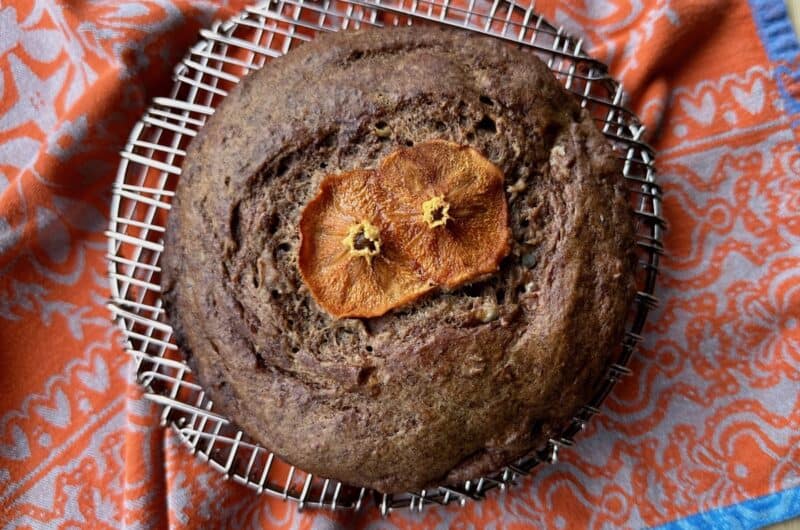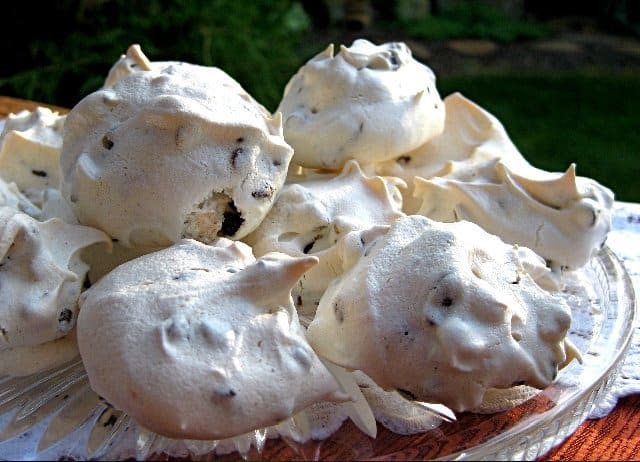The delicate sweetness of ripe persimmons flavors this beautiful nut bread. The rich texture of persimmon pulp and the tones of citrus and warm spice that characterize this unique fruit make Yamini’s Wild Persimmon Cake an unexpected treat that is perfect for snack time or dessert.
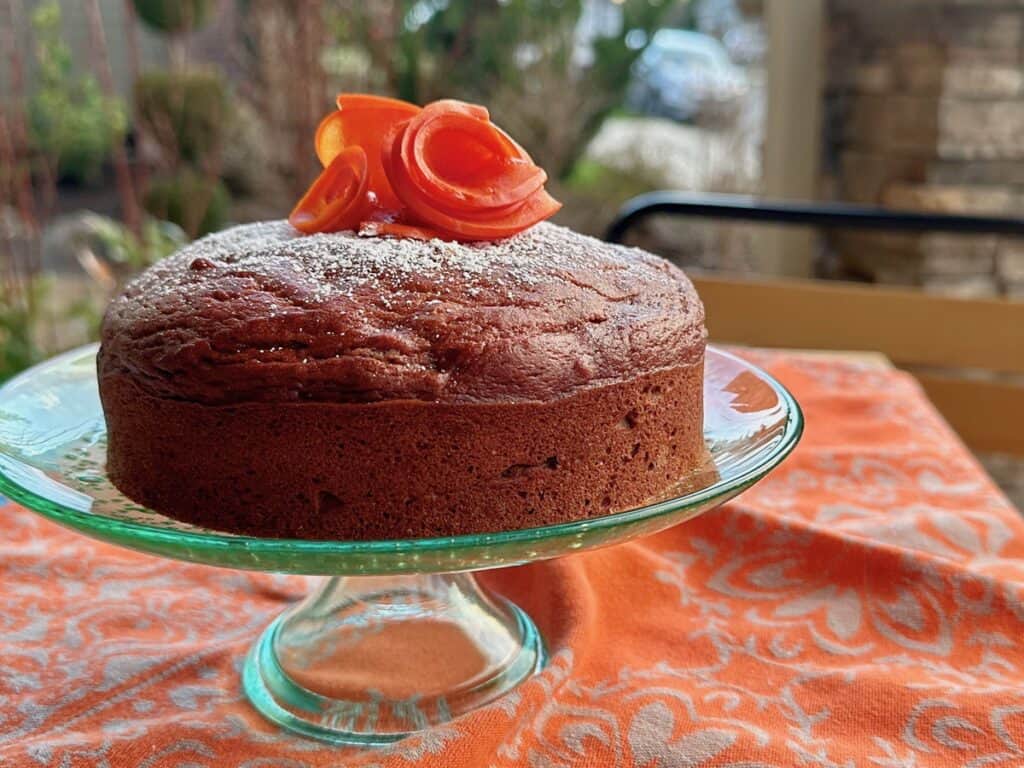
Growing Wild in Southern Indiana
Persimmons grew wild on my grandparents farm in southern Indiana. Like chestnuts, they were natives to the land. As such, they were part of the lore of the land conserved by my grandparents’ generation.
My grandfather prized the chestnuts that grew on the trees near his house. Some years the trees bore abundantly. He faithfully collected the chestnuts when they fell from the branches and removed the prickly burrs with gloved hands. Then he stored the chestnuts in paper bags in the garage, pleased with the result of his harvest. Chestnuts brought a good price at the market back then, as well as a good share of gratitude from those who purchased his hard to find treasures.
By contrast, it was my grandmother who valued the secrets of the persimmon tree. It was also a native tree growing wild on the back acres of their farm, near the highway. In late autumn, when the air was chilly and the branches of the trees were mostly bare, my grandmother’s sense of timing would draw us through the barnyard to the fields beyond. Before we gathered the eggs and stopped by the fence to offer the ponies a sugar cube, we continued past the barn and through the back gate. There the dry grass was scattered with colored leaves that crunched beneath our feet. We walked on as the land rolled down toward Silver Creek.
Choosing Ripe Persimmons
In the field above the creek, Mammaw drew my attention to a tree with a rough weathered trunk and sprawling limbs. Its leaves were scattered and it was nearly bare except for the bright fruit that clung to its branches. More fruit had been shed and was on the ground below.
Mammaw told me that this was a persimmon tree. She inspected the fruit on the ground and gathered those that looked fairly clean and unspoiled. The fruit, she assured me, was good to eat, if you were careful. As she sorted the fruit beneath the tree I looked up through the tangled branches. The bright shade of the orange-red persimmons still clinging to the tree dotted the sky with color.
After Mammaw had collected several persimmons in a basket, she asked if I wanted to taste one. They were wrinkled and soft with a withered leaf on top. To me they looked unappealing. I asked her if I could taste a prettier one, a bright smooth persimmon picked from the tree, instead. She shook her head and warned against it.
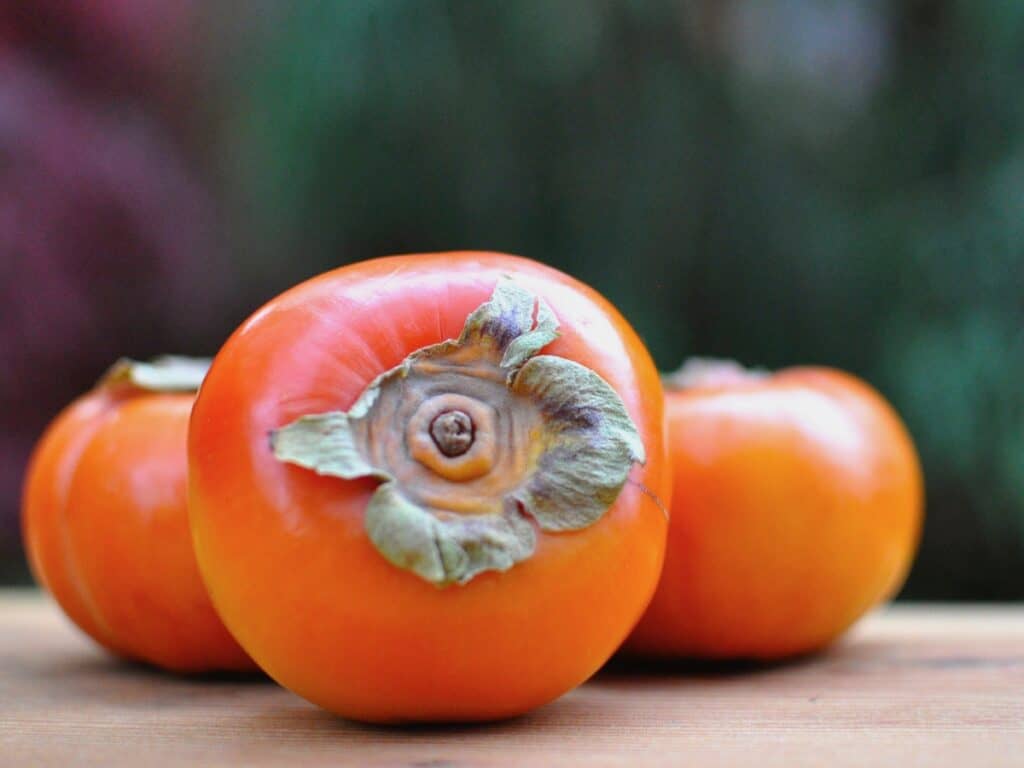
Listening to Mammaw
Mammaw told me that you must be certain a persimmon is ripe before you eat it. She added that the ripe fruit was often not the prettiest. Then she laughed recalling how she had once tasted an unripe persimmon. She bit into it, she told me, and it puckered her cheeks like nothing else she had ever tasted.
I asked if it was like a lemon. I liked lemons and the way their sour flavor lit up my whole mouth when I tasted them plain. Much worse, she told me. I should trust her on that point. Unripe persimmons would draw the moisture from your mouth and send you in search of a remedy, she assured me. They were something to be avoided.
I heeded Mammaw’s warning. In fact it has stuck with me all these years. I could not imagine that a taste more challenging than the tartness of a fresh lemon would be a treasure worth pursuing. As the fruit she offered was wrinkled, soft and unappealing, and I dared not taste the pretty fruit still clinging to the tree, I declined to take any interest at all in persimmons.
A Chinese Persimmon
I left home at eighteen and headed west. Decades passed before I knowingly looked up at another persimmon. It large and bright and was hanging on a tree in the midst of the Lan Su Chinese Garden in Portland, OR. Beyond the entry to the Tower of Cosmic Reflections Teahouse I found myself gazing at a beautiful tree clutching flame colored fruit on its bare branches.
When I consulted the sign beneath the tree, I learned that it was a Hachiya persimmon tree. This variety, which originated in China, grows larger fruit than the common American persimmon I remembered. Still it has many of the same characteristics as the persimmons my grandmother warned me about so long ago. And, perhaps, even more of those qualities that she tried to share with me. I smiled as I admired the tree’s rugged bark, bright fruit and whimsical appearance. It was a happy complement to the patterned stone walkways, the koi and the landscape of this interesting garden space.
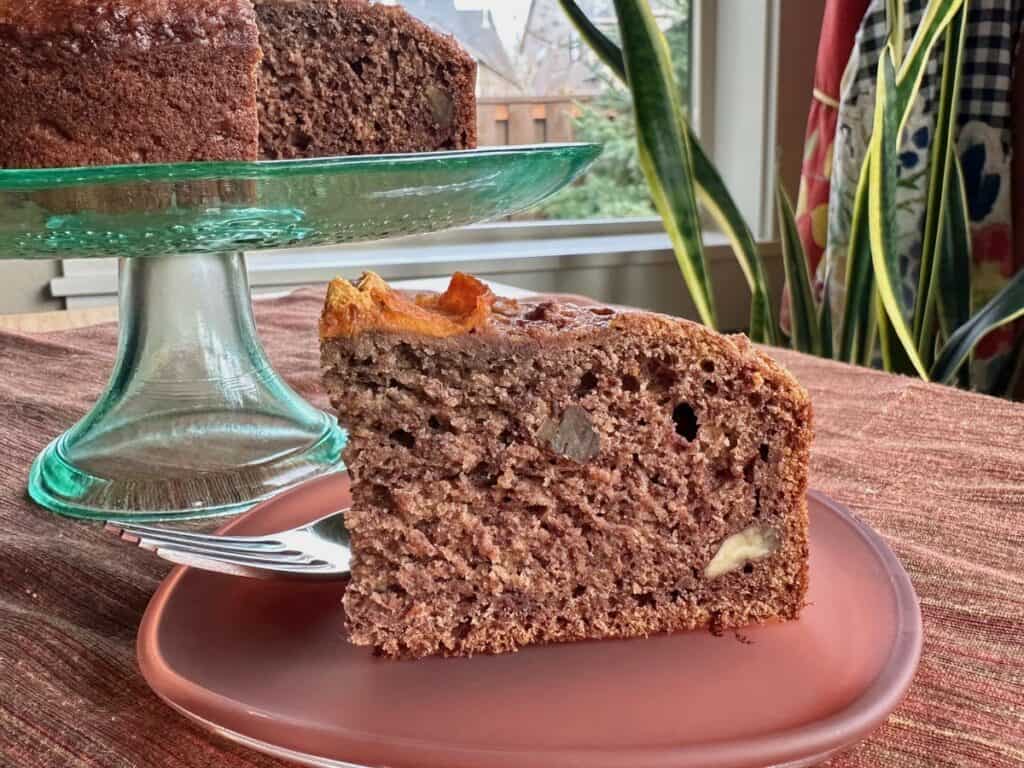
A Gift of Wild Persimmons
Another decade passed. By then I was living in Portland. After spending some time in California, a neighbor stopped by to share something special fresh from the oven. While away, his family had gathered wild persimmons with their friends. When they got home they baked the persimmon pulp into beautiful russet-colored loaves of nut bread. I was delighted that they wanted to share one with me and my family.
I tasted the persimmon loaf carefully. After all, I have heeded my grandmother’s warning all these years. Now, tasting this gift, I found it difficult to discern any disagreeable qualities of the fruit it included. There was no bitterness or sense of pucker. All I could taste was a lightness to the flavor of this dark loaf that perfectly framed the earthy texture of the fresh pecan pieces scattered throughout. Overall the taste was unique and delicious. I found myself captivated by this lovely Persimmon Cake that reminded me of my grandmother. I asked for the recipe and tucked it away in hope that a time would come when I could use it.
Trying Something New
This autumn found me busy and distracted. I am doing more editing these days than writing or cooking. I have been traveling a bit and my husband is traveling even more. My cooking and baking are irregular at best.
I was focused on making time to bake pies for Thanksgiving when my husband came home from a technical meeting in LA with a brown paper sack in hand. He brought it into the kitchen and explained that a coworker had a persimmon tree on his property. This year the tree is wildly abundant and is producing a windfall of persimmons that his coworker was eager to share. My husband told me that he had eaten several. He just chose a pretty one from the bag and bit into it like an apple. He promised that these persimmons were delicious.
Of course I was wary, but I was curious too. While I remembered my grandmother’s words of warning, I also remembered the taste of my neighbor’s Persimmon Cake and I wanted to know more. A quick Google search assured me that, while Mammaw was right to warn me about the bitterness of the underripe fruit from her tree, I could feel safe throwing caution to the wind as I tasted the persimmons my husband brought home.
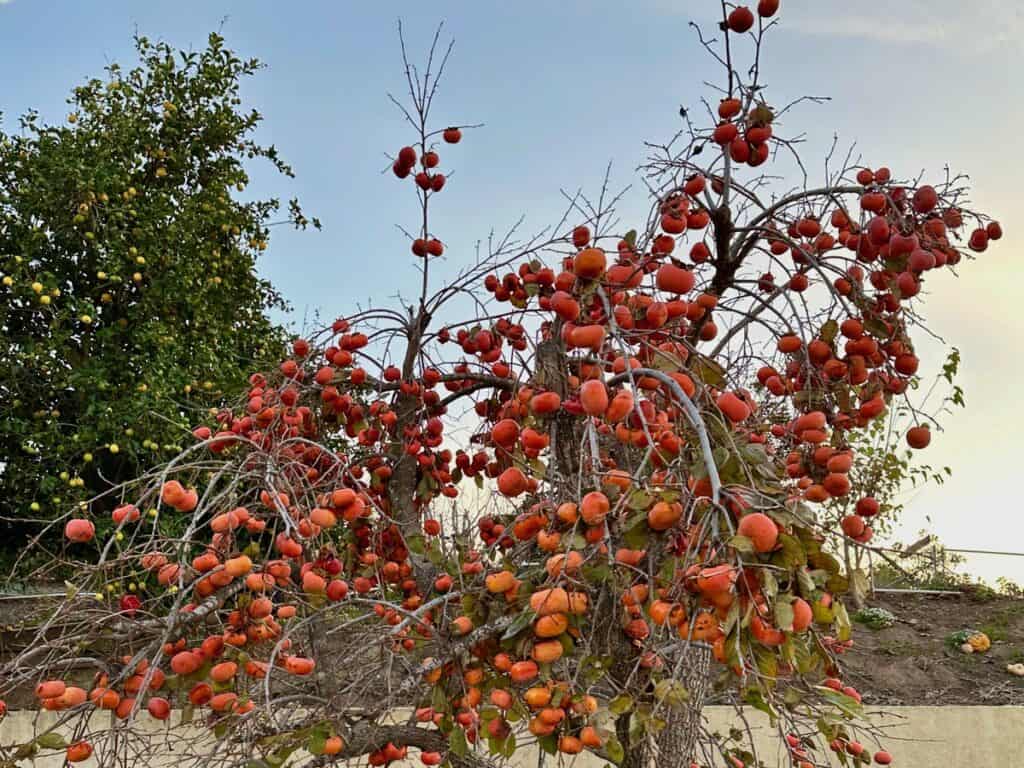
Another Type of Asian Persimmon
The persimmons in the brown sack turned out to be Fuyu persimmons. They are quite different than the persimmons I remembered from my youth. These persimmons, like Hachiyas, are descendants of Asian trees. The difference is that Fuyu persimmons do not have the strong astringency that powers the forbidding pucker of unripe Hachiya and American persimmons. Fuyus can be eaten and enjoyed while the fruit is still firm and brightly colored. They will soften in time, and taste even sweeter, but you don’t have to wait for that stage before daring to taste them or use them in recipes.
Encouraged, I took one of the persimmons from the bag as suggested. Instead of biting straight into it I peeled mine and cut it into slices. These, it turns out, can be added to winter salads or eaten plain. They have a slightly firm, sometimes almost crunchy, texture. The flavor is surprising fresh and light. The sweetness is appealing and satisfying without any lingering unpleasant taste or mouthfeel. It leaves a hint of lemon lime citrus on the roof of my mouth and the flavor of warm baking spices on my tongue. Relatively little sweetener or spice is needed to balance the flavor of ripe persimmon pulp. It has a roundly satisfying flavor on its own.
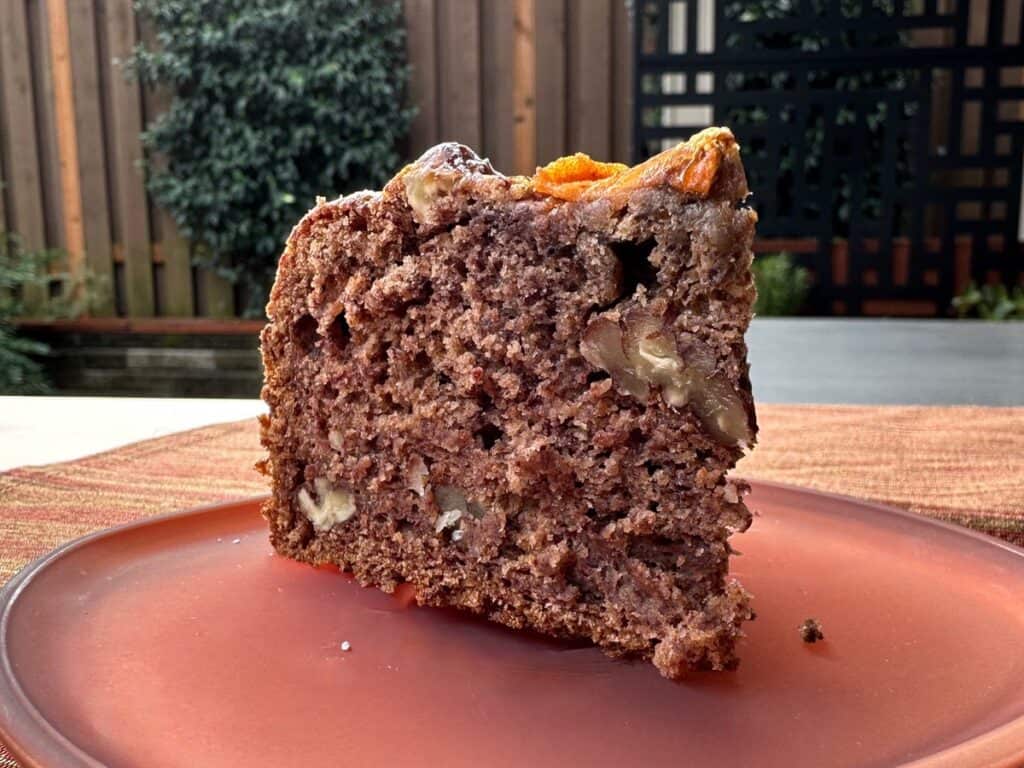
Making Persimmon Puree
Back on task in the kitchen I wondered what to do with the remaining persimmons. That’s when I remembered the recipe for Wild Persimmon Cake from my neighbor. It called for 1 1/2 cups of persimmon pulp. That seemed close to the amount my persimmons would yield.
The challenge was to produce persimmon pulp. With Hachiyas, like the smaller American persimmons, when they are ripe they are soft and the pulp can be easily mashed. These Fuyus were getting softer but were still too firm to mash.
Another search suggested Fuyu persimmons could be pureed in a blender. I was doubtful but I gave it a try. Sure enough, in a minute I had a lovely smooth persimmon puree that was the prettiest autumnal shade of golden orange I could imagine. Luckily I found that I had just the right amount to try my neighbor’s recipe.
Making Yamini’s Wild Persimmon Cake
Yamini’s Wild Persimmon Cake was adapted from a recipe for Zucchini Bread. It makes two 8-inch loaves of bread or two 6-inch round cakes. The recipe calls for a relatively small amount of powdered, rather than granulated, sugar which keeps the sweetness light and brings the flavor of the fruit and nuts forward.
To begin, I carefully measured and mixed the flour, spice and sugar. Then I added the eggs and persimmon puree before folding in a cup full of fresh pecans. (My memory tells me that wild hickory nuts might be an even better addition, but where can I get those short of foraging in the woods back home?) I turned the batter into prepared pans and baked until it tested done.
The result was a beautiful chestnut toned snack cake. Having tasted that Fuyu persimmon on its own I could now discern the subtle flavor the persimmon pulp adds to the bread. The fresh light sweetness delights the roof of my mouth as it lingers. While the amount of sugar in the cake seems unusually light that small measure of powdered sugar adds just the right boost to enhance the sweetness of the fruit without allowing it to cloy. The fruit also adds a hint of citrus and fall spice. I found the flavor to be beautiful especially with the earthy contrast of the fresh pecans. You can also add raisins for a bonus of tangy sweet nuggets and chewy texture, if you like.
Yamini’s Wild Persimmon Cake
12
servings15
minutes1
hour10
minutes1
hour25
minutesPersimmon pulp, rich with the flavors of citrus and warm spice, make this interesting nut bread a delicious seasonal treat. Serve it for snack time or dessert.
Ingredients
3 eggs
1/4 cup (50g) olive oil
1 teaspoon vanilla
1 1/2 cups (14.5 oz or 400g) persimmon puree (see note)
2 cups (10 oz or 280g)) all-purpose flour
1 cup (4.5 oz or 130g) powdered sugar
1 teaspoon baking soda
1/4 teaspoon baking powder
1/4 teaspoon salt
1 teaspoon ground cinnamon
1 cup (120g) pecans, roughly chopped
1/2 cup raisins (optional)
Directions
- Preheat oven to 325F.
- In a medium mixing bowl, whisk together the flour, powdered sugar, baking soda, baking powder, salt and cinnamon.
- In a large mixing bowl, combine the eggs olive oil, vanilla and persimmon pulp.
- Add dry ingredients to the persimmon mixture, stirring until just combined. Fold in nuts.
- Spread batter in two 8-inch loaf pans or in two 6-inch round cake pans. Decorate top with very thin slices of fuyu persimmons or pecan halves, if desired.
- Bake at 325F for 1 hour and 5 or 10 minutes or until top is golden and springs back. Cool on wire rack removing cakes from pans as soon as you are able.
- When cool, dust top with powdered sugar if desired. Serve and enjoy.
Notes
- To make Persimmon Roses: Thinly slice a small persimmon. With a sharp knife, cut each slice radially from the center to the outer edge. Turn the cut edge back on itself and roll the rest of the slice around that axis. Arrange several roses on the top of the cake as a garnish, if desired.

